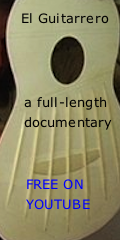Welcome to one of the most active flamenco sites on the Internet. Guests can read most posts but if you want to participate click here to register.
This site is dedicated to the memory of Paco de Lucía, Ron Mitchell, Guy Williams, Linda Elvira, Philip John Lee, Craig Eros, Ben Woods, David Serva and Tom Blackshear who went ahead of us.
We receive 12,200 visitors a month from 200 countries and 1.7 million page impressions a year. To advertise on this site please contact us.
|

|
|
Hot Glue Gun Action
|
You are logged in as Guest
|
|
Users viewing this topic: none
|
|
Login  | |
|

   
estebanana
Posts: 9354
Joined: Oct. 16 2009

|
 RE: Hot Glue Gun Action (in reply to estebanana) RE: Hot Glue Gun Action (in reply to estebanana)
|
|
|
Jeff,
I'm pretty up on glue technology. The very qualities which make hot glue gun glue correct for making jigs are the same reasons it is totally wrong for making guitars. The fact that it releases with impact is one reason. And Anders mentioning the damping factor is a major problem.
Guitar makers want a stiff non pliable glue. Aliphatic resin glues and Poly Vinyl Acrylics like Elmers Wood glue are acceptable, but they still have problems. One thing is if they are not fresh when used they can creep over time.
Pliable or malleable glues sap the guitar of energy because the flexibility of the glue does not transmit vibration and cuts down on resonance. That is basically what we mean when we refer to "damping". Hot glue gun glue has about the highest damping I can think of besides the obvious caulk type adhesives. We want hot hide glue which is animal protein, it comes from cattle hooves, fish skin and swim bladders and other kinds of mammal skin collagen. Like rabbits.
The animal protein glues are the considered by most hard core luthiers to be the best glue for repair work and construction. In fact if you work on the violin family of instruments using any other type of glue can do extreme or unfixable damage to an instrument. Many a self styled repair man has killed a good violin by using Elmer's glue to fix it.
The CA glues or Cyanoacrylates, are very brittle. They do come in different formulations which make them less brittle or have more open drying time. But in the end they tend to glaze the grain shut and make it difficult to do repair work over areas where this glue is employed. I have also contacted a lab in Canada that runs tests on museum archival materials because it was in vogue for some years for restorers and conservators to use CA glues to reconstruct broken wood sculptures. This lab has been running a continuous test on wood structures glued with CA glues and have reported findings which say the glues fair well under dry conditions, but are effected by trace amounts of moisture.
CA glues have two kinds of bases Butyl and Ethyl, of the two the Butyl based CA seems to last longer under adverse conditions. Many luthiers depend on CA glues to do work such as bindings ( which in my opinion is pure folly and totally incorrect) or to glue parts back together like broken corners on violin bow parts. CA glues seem to be a good long lasting repair on dense non porous woods like Ebony and woods like rosewood. However the long lasting effects of gluing woods of different porosity together has yet to stand the test of time.
The connection between spruce and a hard wood like rosewood is what is up for speculation. How long with a joint between to different materials last under stress conditions and if you add the possibility of moisture opening a closing the joint due to expansion and contraction? The Canadian research lab speculated that some CA glue could have a life time of perhaps 80 years.
I stick with the hot hide animal protein glues, no sense in getting a bunch of stuff on there that is too brittle or too soft. Luthiers have gone in circles about glues for years and with the exceptions of a few instances where synthetic glues are valuable most agree now that hot hide glue is the base glue. In the case of flamenco guitars hide glue or a high quality fresh PVA type glue is essential. Other types of guitars require some special uses of epoxies, CA glue, Polyurethane glues etc.
The use of hot glue gun glue on the Valencia guitars will eventually fail, whether it fails under compression or stress from impact or over time, it will release at some point. Even hide glue will eventually release, but it has the quality of being water soluable and the protein bonds have been proven to last for hundreds an hundreds of years. When hide glue does break down due to dessication is can be easily removed and reapplied and the renewed joint can last several more decades to hundreds of years.
Everyone should glue guitars together with hot glue gun glue, that way I and others as repair people would never have a lack of work reconstructing instruments which fall apart in a few years.
_____________________________
https://www.stephenfaulkguitars.com
|
|
|
|
REPORT THIS POST AS INAPPROPRIATE |
Date Feb. 9 2012 18:45:27
 |
|
 New Messages New Messages |
 No New Messages No New Messages |
 Hot Topic w/ New Messages Hot Topic w/ New Messages |
 Hot Topic w/o New Messages Hot Topic w/o New Messages |
 Locked w/ New Messages Locked w/ New Messages |
 Locked w/o New Messages Locked w/o New Messages |
|
 Post New Thread
Post New Thread
 Reply to Message
Reply to Message
 Post New Poll
Post New Poll
 Submit Vote
Submit Vote
 Delete My Own Post
Delete My Own Post
 Delete My Own Thread
Delete My Own Thread
 Rate Posts
Rate Posts
|
|
|
Forum Software powered by ASP Playground Advanced Edition 2.0.5
Copyright © 2000 - 2003 ASPPlayground.NET |
0.09375 secs.
|


 Printable Version
Printable Version













 New Messages
New Messages No New Messages
No New Messages Hot Topic w/ New Messages
Hot Topic w/ New Messages Hot Topic w/o New Messages
Hot Topic w/o New Messages Locked w/ New Messages
Locked w/ New Messages Locked w/o New Messages
Locked w/o New Messages Post New Thread
Post New Thread